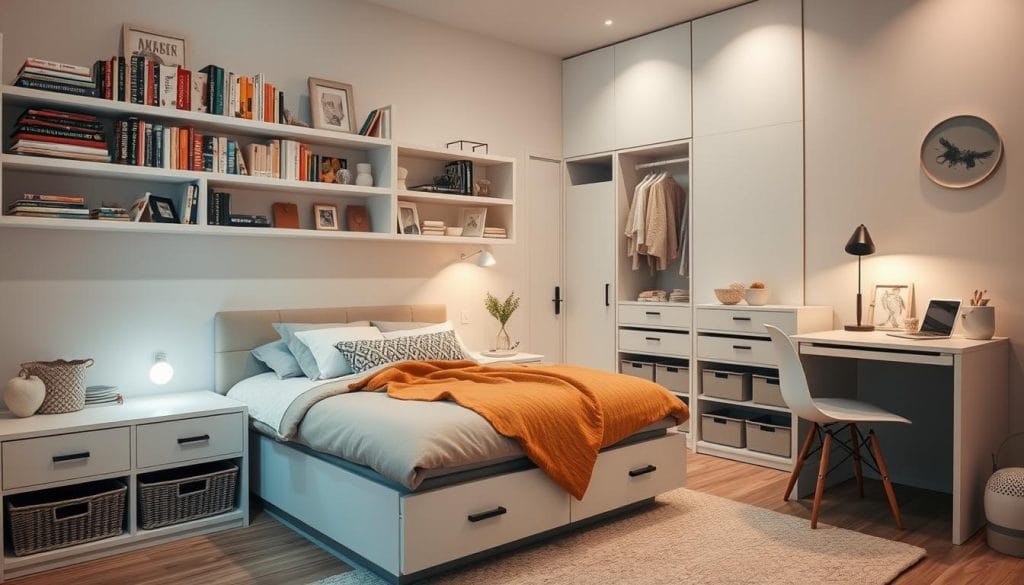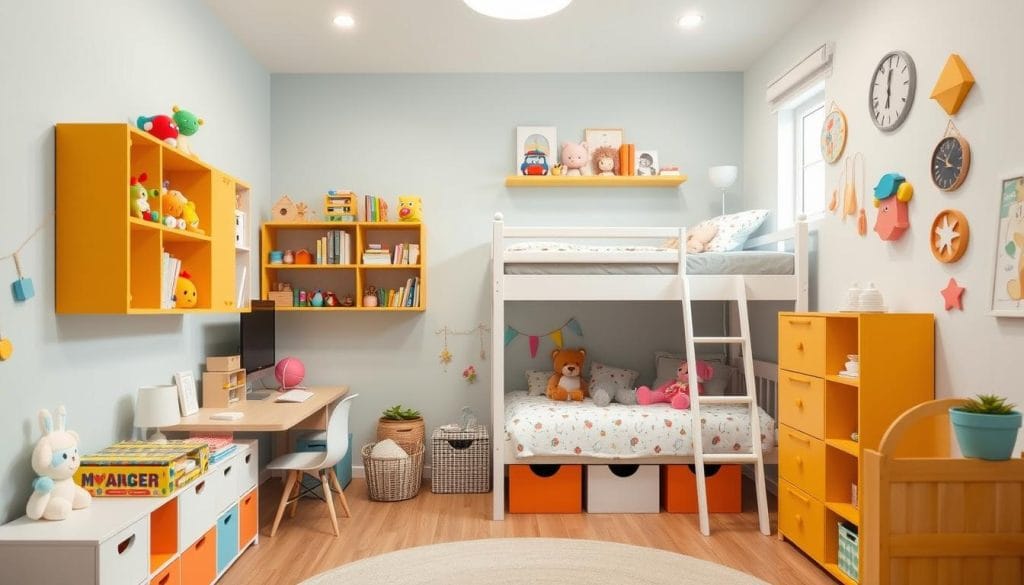I began with a vision not just for a place packed with toys, but for a sanctuary. It was to be a space where imaginations could soar and feel as comforting as a hug. Looking through countless ideas for kids’ bedrooms, I discovered something important. A great playroom nurtures creativity, independence, and growth. It wasn’t just about the decor. It was about making a magical spot that grows with them and their boundless curiosity.
Every element, from the softest rugs that welcome them to dream, to adaptable furniture, is crucial. Imagine their artwork decorating the walls or a family heirloom bed adding tradition. These aren’t just items; they’re future memories1. Luckily, creating this space doesn’t have to break the bank. Most needed items for a child’s room are under $50, making a delightful yet functional space achievable2. This journey should mix practicality with dreams, ensuring everything adds joy and usefulness.
Let’s dive into the 15 must-haves for turning a simple room into a cozy retreat where dreams come to life. Whether opting for playful animal-themed furniture from Wayfair or timeless, handed-down beds, we’re here to help and inspire. Follow along as we make a cozy haven for your child.
Understanding the Importance of a Cozy Kids’ Play Space
A cozy play space helps children grow by letting them explore and learn. This kind of space boosts pretend play and thinking skills, vital for their development3. Sensory experiences, as described by Jean Piaget, are key for learning during early stages3. So, making a creative play space is more than just fun; it aids in nurturing young minds too.
Using kid-friendly design tips makes learning better for youngsters. Since babies’ eyesight is not fully developed, bright patterns and colors capture their interest3. Also, designing spaces for small kids, with 77% of educators saying it boosts learning, meets their unique needs4. Adding elements that allure and stimulate them is essential.
Play spaces aren’t only for learning but for moving too. Furniture that kids can use by themselves supports their independence3. Nearly 90% of educators believe that safe, welcoming spaces build trust, vital for a child’s well-being4.
Adding books and interactive materials also aids in brain growth. Activities like reading and talking with children strengthen their minds3. By choosing these design tips, you’re not just creating a play area. You’re making a place where your child can flourish.
Choosing the Right Space for Your Play Area
Finding the perfect spot for your children’s play area is vital. It’s about striking a balance. There should be plenty of room for kids to use their creativity. At the same time, the space should work well for adults in the house too.
Bonus Room
A bonus room gives your kids a special spot just for fun. Here, they can play without interrupting others. Most of the 33 ideas we looked at suggested using fun decorations and smart storage5. Things like chalkboard paint and shelves make the room look great and function well.
Adding child-friendly furniture makes the space comfy and engaging5. Think about cozy chairs and tables just their size.

Repurposing Existing Spaces
If you’re short on extra rooms, get creative with spaces you already have. Maybe use a loft, a big closet, or a corner of the living room. The goal is to fit the play area naturally into your home’s style. In tight spaces, smart storage is key6.
Try cabinets or lockers against a wall for neatness6. Or, use bins under a sofa and baskets on shelves for easy clean-up. These tricks help you make the most out of small spaces and keep everything tidy for your kids.
Incorporating Storage Solutions
Keeping a kids’ playroom tidy is easy with the right storage ideas. Using closets for toys, adding shelves, and even old suitcases can help. This makes the room better7.
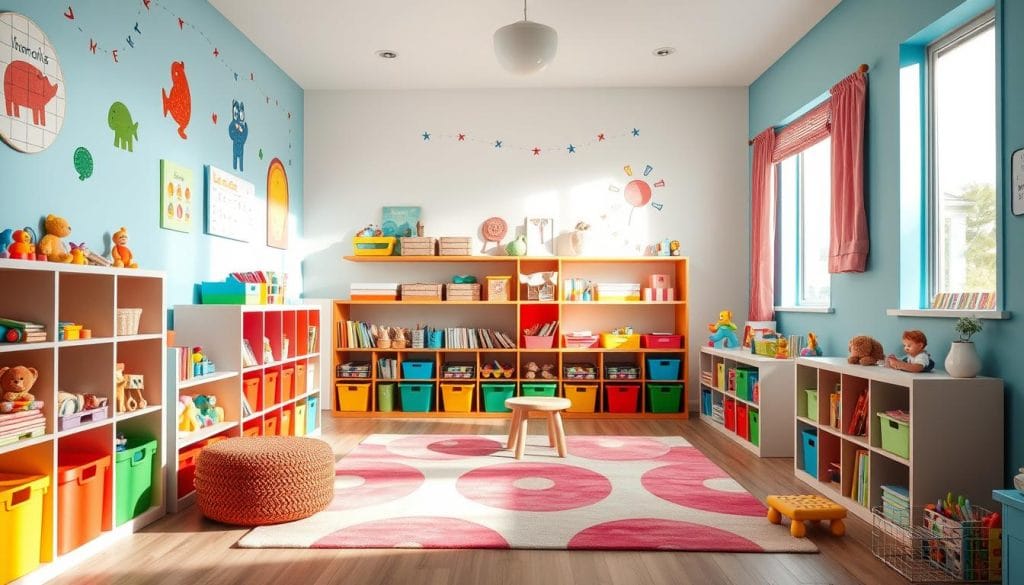
Storage Baskets and Bins
Baskets and bins are a must-have for organizing toys. They let kids help clean up and find toys fast. Around 72% use labeled bins, and 28% prefer clear ones for seeing inside8. Materials like wood, fabric, and plastic are popular, being used 36%, 24%, and 20% of the time8. Wicker baskets add a warm touch to about 16% of storage setups8.
Try using garage spaces or book towers for storage. Crates and furniture like dressers can also create more space. This keeps the room looking nice7. Check out more tips at this link.
Built-in Shelves and Cabinets
Built-in shelves and cabinets are great for keeping toys and books in order. They make the room organized and neat. Designers suggest using furniture that serves more than one purpose7. It’s smart to label drawers and use desks for storing special items7.
About 4% of storage setups have seats inside them. This is clever for small areas8. Customizable bins are getting popular in 4% of designs. They offer a neat and easy way to sort toys8. Picking storage in one color, like white, makes everything look clean. This idea is in 4% of toy storage plans8.
Furniture Choices for a Playful Environment
To make a playroom fun for kids, pick furniture that looks good and works well. The most important thing is that it’s safe, strong, and just the right size for kids. It’s key to choose pieces that are easy to clean. For example, having open shelves helps kids see and reach their toys, making playtime easier9. Also, storage ottomans or tables with places to draw are great for many activities.
It’s smart to choose furniture that can do many things. Did you know about 5% of playroom tips suggest pieces that change, like floor cushions that become beds10? This makes it easy for the space to change as your child grows. Around 10% say to get items that boost creativity, like rugs for activities or walls they can draw on9.
Having the right storage furniture is also key; about 20% of ideas focus on how to store things well10. Fun storage, like cool bins and boxes, keeps things tidy and looks great. Using space smartly means fun and function can be in the same place. Loft beds, for instance, are fun on top and below can be for storage or a reading spot11.
To make a playroom welcoming, comfy furniture like plush throws, soft seats, and cozy spots are important. Nearly 10% of tips suggest soft things to make the room inviting10. Adding comfy chairs for grown-ups means everyone can enjoy the space10. So, when picking furniture for a kid’s playroom, think about both creative and cozy to make the room great for you and your kids.
Bright and Stimulating Color Schemes
Picking bright, lively colors for a child’s playroom can boost their creativity. It makes playtime more fun and imaginative. Such choices can deeply influence your child’s joy and creativity.
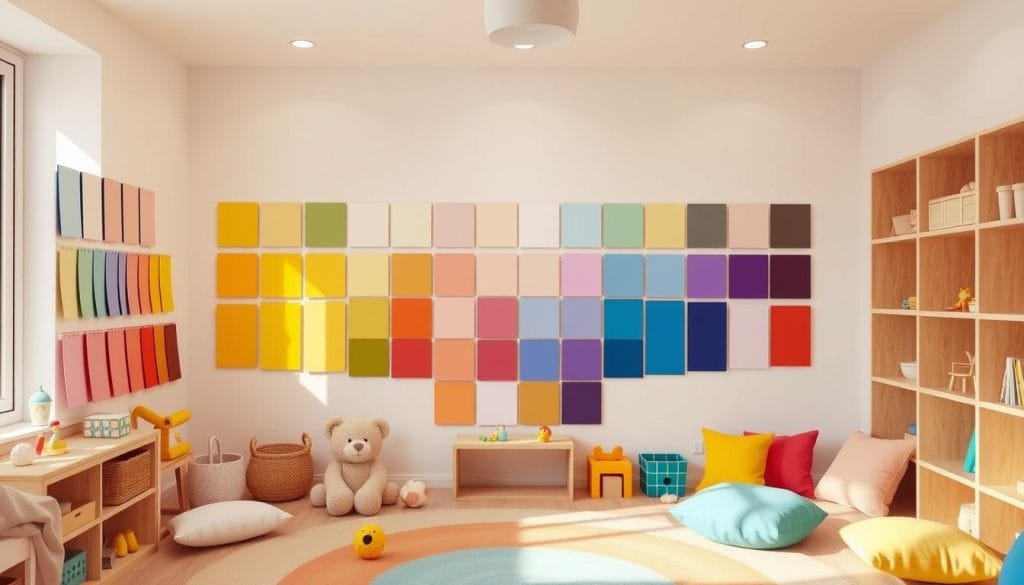
Paint Colors
Bright paint colors can light up a child’s imagination. They make the play area more fun and inviting. Studies show some colors can help with learning and feeling comfortable. These are key for a child’s growth12. Choosing safe, vibrant non-toxic paints is important for a dynamic space. Barry Dixon suggests using bright pink for a fun space13.
Blues and greens are also good. They calm the mind and help kids focus12. These colors can make a room where play and peace meet.
Colorful Rugs
Colorful rugs can make a playroom look better and feel softer. They add color and define play areas. Soft pink or pastel rugs make a place cozy and welcoming13. Emily C. Butler proposes vivid green rugs that can grow with your child’s taste13.
Multicolored rugs can make a playroom exciting. They are perfect for sparking creative play. This turns a playroom into a vibrant world of imagination.
Art and Craft Station Essentials
Having a special spot for art and crafts is key for boosting creativity. It helps kids with their fine motor skills too. By setting up an area for art in the playroom, kids get a neat space to explore their ideas.

Chalkboard Wall
A chalkboard wall in the playroom is perfect for kids to show their creativity. It’s not just fun; it’s easy to clean for parents. Plus, kids can use it for drawing, writing, or even educational games14.
This wall helps with learning and being creative14. Having different art tools is important. It lets kids express themselves and grow emotionally14.
Art Supply Storage
Keeping art supplies in order can be tough. Yet, good storage solutions help a lot. Clear bins or shelves make finding things easy and keep the area tidy. Using shelves, pegboards, and wall storage makes the most of space15.
Try organizing with labeled baskets or other furniture for a neat look. This keeps the art station welcoming and clean15. A well-organized space boosts creativity. It lets kids get their materials without any hassle15.
Essential Play Elements: Toys and Games
Having a variety of toys and games is key for a great playroom. These items should help with learning and imagination. Let’s look at what toys are best for fun and growth.
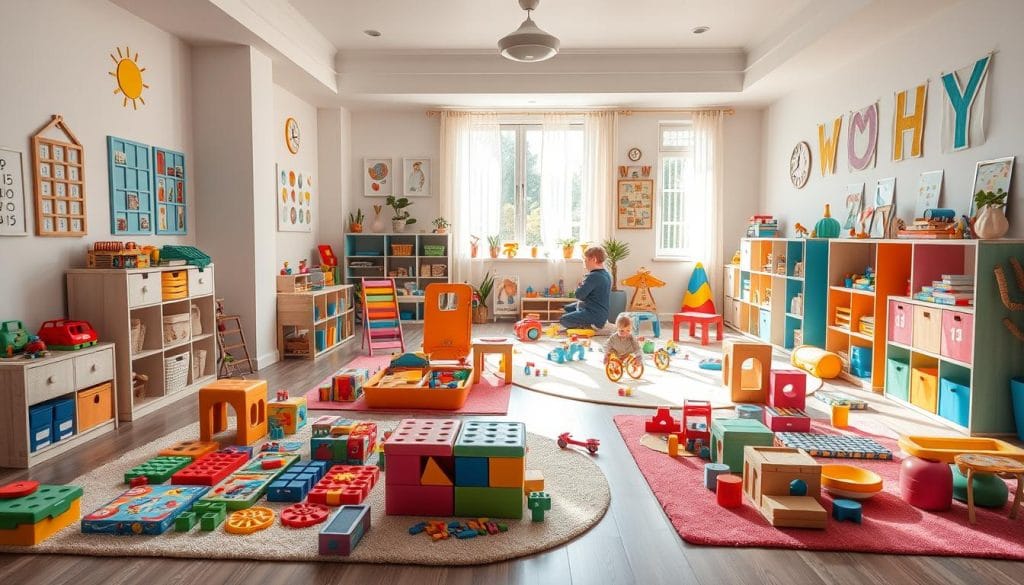
Building Blocks
Building blocks are a must in any play space. They boost creativity, problem-solving, and motor skills. Kids learn about space and coordination by playing with blocks. This play also helps them make friends by building together. Wooden blocks are a top choice in Montessori spaces for hands-on learning16.
Don’t forget about magnetic or foam blocks for little ones. They make the play safer and more fun17.
Interactive Toys
Interactive toys help kids grow by stimulating their senses. They include features like lights, sounds, and different textures. Adding a ball pit or balance boards is a great way to encourage active play and sensory learning16. Musical instruments, like drums and xylophones, are great for building creativity and music skills18.
Toys that mix play with digital tech can also be really educational. They bring together the best of both worlds.
Choosing the right toys, like blocks and interactive items, makes a playroom both fun and educational. It’s important to have these to help kids learn and keep them happy.
Creating a Reading Nook
Making a cozy spot for kids to read in a playroom reading corner is fun and rewarding. First, pick comfortable chairs. Beanbag chairs and big armchairs are awesome. Did you know comfortable seating is key in many designs19? Adding soft pillows and blankets makes it even cozier. This is shown in several designs19.
It’s important to have bookshelves kids can reach. Many designs include book storage solutions. Almost 70% of kids’ room ideas have book nooks20. Keep favorite and new library books handy. This encourages kids to explore new stories anytime they want21.
Good lighting is crucial for cozy reading spaces for children. Using natural light is popular. Some designs suggest large windows for a friendly atmosphere19. Fairy lights or soft lamps add magic, making the corner special for reading20.
Fun decor is a big plus. Things like pompom garlands and toy trophy heads attract kids, as do some wallpapers. Also, 60% of examples use engaging elements like world maps and animal decorations. This makes reading both fun and educational20.
Let your child help design their reading nook. They might pick a stuffed toy or a special book21. A nook that feels like theirs makes reading an exciting adventure!
Happy reading and happy designing! 🌟📚✨
Incorporating Nature into Playrooms
Bringing nature into playrooms makes them welcoming and creative. It helps kids grow in many ways. Let’s find out how to mix the outside with the inside!
Starting with natural light is easy. Place playrooms by big windows to let in sunlight. This makes the room bright and helps kids feel better and focus more.
Adding plants makes a big difference too. Try easy plants like snake or spider plants. They clean the air and teach kids to care for something.
Choose natural stuff for furniture and decorations. Use wooden tables, rattan shelves, and toadstool baskets. Such natural items are becoming more popular in playrooms22.
Pick earthy colors for a nature-themed room. Soft pastels can make the room calm and balanced22. Yellow can make it cheerful and bright22.
Making a play space with nature in mind is fun and simple. Whether with plants, sunlight, or wood furniture, small steps can make a big difference. It helps kids feel closer to nature at home.
Having a nature-themed playroom can boost creativity, help with learning, and make a nice place to play. This offers many benefits that cannot be overlooked.
Safety and Durability in Kids’ Play Spaces
When designing a child’s play space, safety and durability are top priorities. The choices of layout and materials make a big difference. They keep kids safe and draw them in. Non-toxic paints and strong furniture help kids explore without worry.
Safety in play areas has been key since the 1800s playground movement. Equipment now has soft edges and gentle grounds to lessen hurts23. Durable playroom items last through lots of active play. This idea comes from Friedrich Froebel who talked about the value of learning spaces for kids24.
All equipment in the play space must be very safe. School playgrounds have climbing spots fit for 5 to 12-year-olds. They help with coordination, balance, and strength23. Playroom furniture should also be secure and have soft or round corners to avoid injuries.
Playrooms need to be versatile and useful too. Good design leads to better play and friend time. It turns a regular room into a kid-friendly space. Smart layout uses space well and keeps things tidy24.
| Age Group | Safety Features | |
|---|---|---|
| Playgrounds for Ages 5-12 | School-age | Climbing structures, Coordination elements, Balance features (Source: Playground movement data)23 |
| Play Spaces | Pre-school/childcare | Non-toxic materials, Cushioned corners, Anchored furniture (Source: Childcare setting organization)24 |
Using these ideas, you can make a play area that’s safe and fun. Safe materials and strong furniture don’t just prevent risks. They also support a child’s creativity and discovery. This helps children make the most of their playtime.
Themed Play Areas for Imaginative Play
Themed playrooms are great for kids to play make-believe and grow their imagination. We aim to create joy and endless fun for kids in these areas.
Dress-Up Area
A dress-up area lets kids pretend to be different characters. They can be superheroes or fairy tale characters. A mirror or small stage helps them act out their stories. Plus, a whimsical Dutch door adds beauty and function to the space25.
Play Kitchen
Play kitchens let kids pretend to cook and do house chores. Adding real-looking appliances and play food makes playtime fun. Keeping big furniture simple lets the play area change as kids grow25. Kids learn important skills while playing.
Interactive Wall Art and Decor
Interactive wall art changes your child’s playroom. It makes the area exciting and boosts creativity. These items not only look good but also let kids do fun activities. They help with thinking skills and imagination.
Chalkboard Paint
Using chalkboard paint makes the playroom flexible. Kids can draw or practice writing in a fun way. It’s cheap and can change with your child’s interests. Many families love it for its fun and adaptability26.
Statement Pieces
Large artworks or sensory boards can make a playroom creative. They should be interactive and offer many activities. For instance, the Bare Conductive Touchboard Kit adds sound by touch27. Also, photo murals or travel maps can teach geography and personalize the space26.
Adding interactive decor helps your child grow and be creative. It combines fun and use to inspire kids daily. This makes their play areas exciting and enriching.


